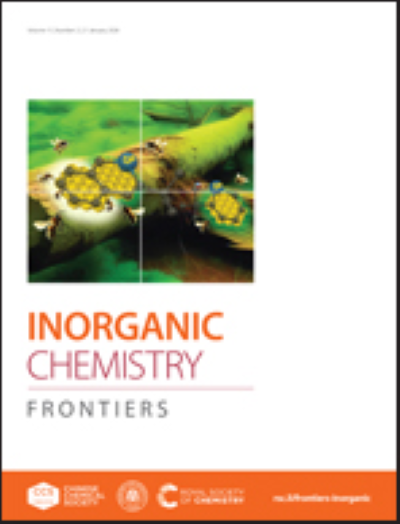探索[Ru(4,4 ' -BTFMB)2 (L)]2+配合物(L = bpy, phen, TAP)作为光动力治疗剂的光物理和激发态反应性:理论研究
IF 6.1
1区 化学
Q1 CHEMISTRY, INORGANIC & NUCLEAR
引用次数: 0
摘要
在这项工作中,我们探索了三种不同的[Ru(4,4 ' -BTFMB)2 (L)]2+配合物(C1: L = bpy(2,2 ' -联吡啶);C2: L = phen (1,10-phenantroline);和C3: L = TAP(1,4,5,8-四氮杂蒽))),旨在研究配体对其光物理和光化学性质的影响,并评价其作为光动力治疗(PDT)的光敏剂(PS)的适用性。化合物C3是一个新的理论命题,我们已经观察到HOMO和LUMO能量的显著降低,这可以解释为配合物的额外稳定,这是PS候选物非常理想的特征。此外,低空激发态的跃迁性质也发生了转变,证实了第三配体中电负性更强的原子由于更有效的π背键而降低了轨道的能量。此外,对激发态反应的研究表明,这三种配合物具有双重性质的可能性,在热力学上有利于通过能量转移使分子氧光敏,并通过电子转移使鸟苷-单磷酸氧化。配合物C3表现出最佳的反应自由能谱,表明该新化合物最适合作为PDT中的光敏剂使用。本文章由计算机程序翻译,如有差异,请以英文原文为准。
![Exploring the photophysics and excited state reactivity of [Ru(4,4′-BTFMB)2 (L)]2+ complexes (L = bpy, phen, TAP) as photodynamic therapy agents: a theoretical investigation](https://img.booksci.cn/booksciimg/2025-4/2025041010074415021974.png)
Exploring the photophysics and excited state reactivity of [Ru(4,4′-BTFMB)2 (L)]2+ complexes (L = bpy, phen, TAP) as photodynamic therapy agents: a theoretical investigation
In this work, we explore the excited states of three different [Ru(4,4′-BTFMB)2 (L)]2+ complexes (C1: L = bpy (2,2′-bipyridine); C2: L = phen (1,10-phenantroline); and C3: L = TAP (1,4,5,8-tetraazaphenanthrene)), aiming to investigate the ligand effects on their photophysical and photochemical properties and also to evaluate their suitability as photosensitizers (PS) for photodynamic therapy (PDT). Compound C3 is a new theoretical proposition for which we have observed a significant lowering in the HOMO and LUMO energies, which can be interpreted as an extra stabilization of the complex, a highly desirable feature for a PS candidate. Also, the low-lying excited states showed a shift in the MLCT transition nature from  to
to  , confirming that the presence of a more electronegative atom in the third ligand lowers the energy of the orbitals due to a more effective π-backbonding. Furthermore, the investigation of the excited state reactions has shown a dual character possibility for the three complexes, being thermodynamically favorable for photosensitizing molecular oxygen through energy transfer and oxidizing guanosine-monophosphate through electron transfer. Complex C3 presented the best reaction free-energy profile, indicating that this new compound is most suitable for use as a photosensitizer in PDT.
, confirming that the presence of a more electronegative atom in the third ligand lowers the energy of the orbitals due to a more effective π-backbonding. Furthermore, the investigation of the excited state reactions has shown a dual character possibility for the three complexes, being thermodynamically favorable for photosensitizing molecular oxygen through energy transfer and oxidizing guanosine-monophosphate through electron transfer. Complex C3 presented the best reaction free-energy profile, indicating that this new compound is most suitable for use as a photosensitizer in PDT.
 to
to  , confirming that the presence of a more electronegative atom in the third ligand lowers the energy of the orbitals due to a more effective π-backbonding. Furthermore, the investigation of the excited state reactions has shown a dual character possibility for the three complexes, being thermodynamically favorable for photosensitizing molecular oxygen through energy transfer and oxidizing guanosine-monophosphate through electron transfer. Complex C3 presented the best reaction free-energy profile, indicating that this new compound is most suitable for use as a photosensitizer in PDT.
, confirming that the presence of a more electronegative atom in the third ligand lowers the energy of the orbitals due to a more effective π-backbonding. Furthermore, the investigation of the excited state reactions has shown a dual character possibility for the three complexes, being thermodynamically favorable for photosensitizing molecular oxygen through energy transfer and oxidizing guanosine-monophosphate through electron transfer. Complex C3 presented the best reaction free-energy profile, indicating that this new compound is most suitable for use as a photosensitizer in PDT.
求助全文
通过发布文献求助,成功后即可免费获取论文全文。
去求助
来源期刊

Inorganic Chemistry Frontiers
CHEMISTRY, INORGANIC & NUCLEAR-
CiteScore
10.40
自引率
7.10%
发文量
587
审稿时长
1.2 months
期刊介绍:
The international, high quality journal for interdisciplinary research between inorganic chemistry and related subjects
 求助内容:
求助内容: 应助结果提醒方式:
应助结果提醒方式:


